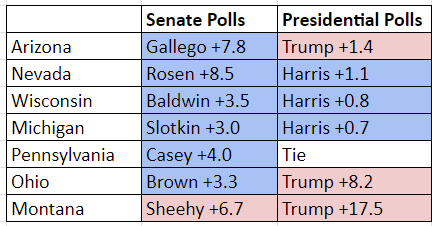Senate Polling: Are Split Tickets Back?
October 8, 2024
Ticket splitting for federal races, where voters in a state pick a president from one party and a senator from another when both candidates are on the same ballot, has been declining since the 1980s. But current polling trends indicate that some states may be on track to revive the practice.
- Federal ticket splitting reached a historical low in 2016 when zero states had a party mismatch between the presidential and Senate candidates in those states.
- In 2020, Maine was the only ticket splitter with Sen. Susan Collins (R-ME) winning re-election and President Joe Biden winning the statewide presidential vote.
- Click here to read more about the history and trends of ticket splitting.
Why it matters: Seven races this cycle will decide which party controls the Senate come January. As shown in the table below, Democratic Senate candidates continue to outpoll Harris when comparing the polling averages of the leader in the presidential election.

Polls as of Monday, Oct. 7, on RealClearPolitics. For a link to all the polls click here.
If the polling carries through to election day, states like Ohio and Arizona could vote for Former President Donald Trump in the presidential election, while simultaneously sending Senators of the opposite party to Congress.
This trend is manifesting itself in different ways depending on which region of the country you study.
- The Sun Belt states of Arizona and Nevada have Democratic nominees that are polling between seven and nine points ahead of Harris and Trump’s lead in their states.
- In the Midwest/Mid-Atlantic region, the states of Ohio, Wisconsin, Michigan and Pennsylvania have candidates polling about three and four percent ahead of Harris’ lead.
- In Montana, Sen. Jon Tester (D-MT) is running nearly 10 points ahead of Trump, but it may not be enough to re-elect him. The Montana race had been rated competitive at the beginning of the cycle, but in recent weeks it has shifted decisively for the Republican candidate, Tim Sheehy, as Tester is running almost 7 points behind him.
There is not one single data point to explain this phenomenon, but one fact is shared between all these candidates.
- Every incumbent Democratic candidate has name recognition with voters as they have all won statewide federal elections previously. This may be one of the reasons they are polling ahead of the presidential ticket.
- Democratic Senators Tester, Sherrod Brown, Bob Casey and Tammy Baldwin are running for re-election, having served two or three terms; voters know them well and are aware of their records.
- The open seats in Michigan and Arizona are more complex. Rep. Elisa Slotkin (D-MI) and Rep. Ruben Gallego (D-AZ) are running as newcomers to the Senate after having served multiple terms in Congress. Their success may be more on the individual dynamics of their races or a dissatisfaction with the Biden administration.
The bottom line: The famous maxim “all politics is local” may still hold true, as these Senate candidates have been able to carve out a lane for themselves separate from the top of the ticket.
Contact James Montfort (Jmontfort@crefc.org) with any questions.